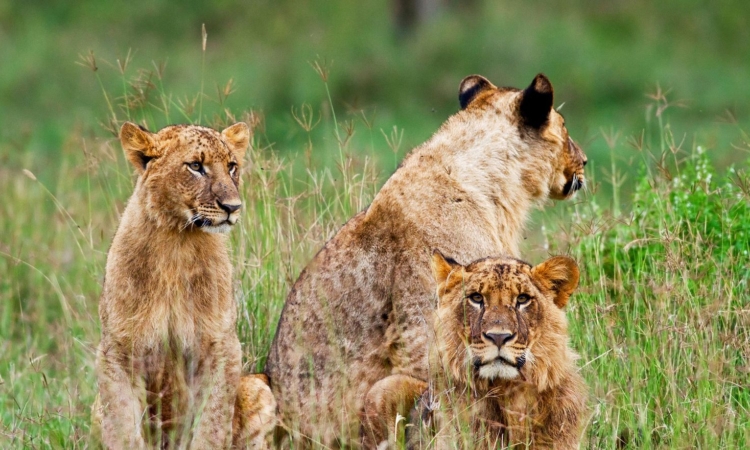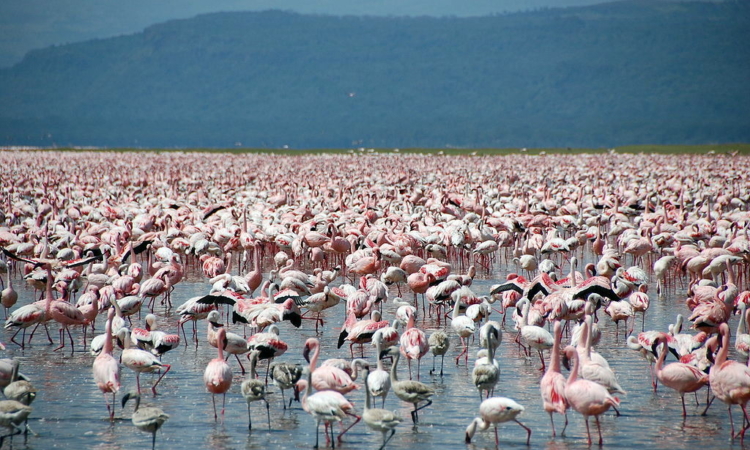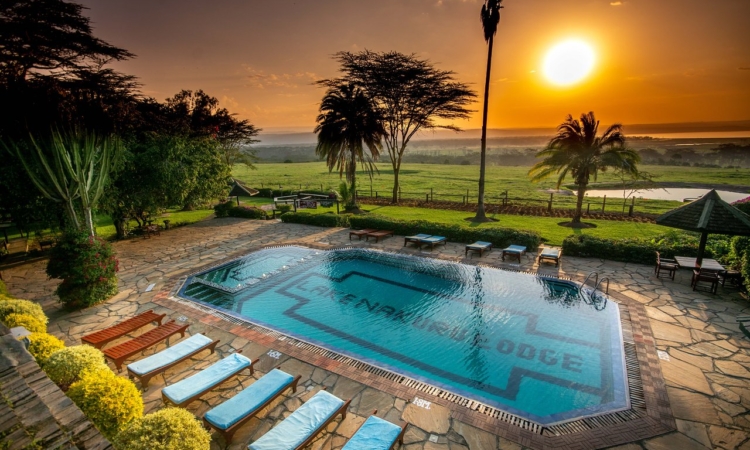Ultimate Guide for Lake Nakuru National Park Safaris & Travel
If you are looking for a great place for bird watching, then visiting Lake Nakuru National Park during your Kenya safari holiday will not disappoint you.
Located in Nakuru County, along the Great Rift Valley, this park covers about 188 square kilometers. Lake Nakuru National Park is one of the best places to visit in Kenya for nature and wildlife lovers.
The park is named after Lake Nakuru, which lies at an altitude of about 1754 meters. The lake takes up around 27% of the park and is known for its unique ecosystem.
Lake Nakuru National Park was officially made a national park in 1961. It is located right next to Nakuru Town and is best known for the huge flocks of flamingos that gather along its shores.
But the park is not just about birds. It also has many other animals that visitors can see during their Kenya safari.
Location of Lake Nakuru
Lake Nakuru National Park is in Central Kenya, about 140 kilometers northwest of Nairobi, the capital city.
It is a great place to enjoy the sight of flamingos and other wildlife while on safari.
Lake Nakuru Park Entry Fees
Lake Nakuru National Park is one of the most visited birding areas in Kenya and Africa. It is managed by Kenya Wildlife Services (KWS), the body that sets park entry fees.
Visitors can see millions of pink flamingos clearly along the shores of Lake Nakuru.
Park fees are based on visitor category: whether you are a citizen, resident, non-resident, student, adult, or child.
- Kenyan citizens need a valid ID or passport.
- East African Community citizens must show a valid ID from their home country.
- Residents (foreigners living or working in Kenya) need valid Kenyan-issued documents.
- Non-residents are visitors from outside Kenya and the EAC.
- Students visiting for research or learning have their own fee category.
Lake Nakuru National Park entry fees (valid for 24 hours):
- Citizens: Ksh 860 (adult), Ksh 215 (child)
- Residents: Ksh 1030 (adult), Ksh 515 (child)
- Non-residents: $60 (adult), $35 (child)
Activity fees in Lake Nakuru National Park include:
| Activity | Cost (Kshs.) |
|---|---|
| Night game drives per trip | 2155 |
| Horse riding (exclusive of rider) | 2585 |
| Cycling per day | 215 |
| Horse riding on a private horse | 1030 |
| Walking tours per day | 1500 |
The annual passes (valid for a year) are as follows:
| Annual Pass Type | Cost (Kshs.) |
|---|---|
| Adults | 43100 |
| Children | 10340 |
| Corporate annual pass | 103440 |
| Tour driver personalized annual pass | 6000 |
Camping Fees in Lake Nakuru National Park
Camping fees in Lake Nakuru National Park are charged based on the type of campsite and visitor category.
Special Campsites:
- Citizens: Ksh 500 for adults, Ksh 250 for children
- Residents: Ksh 600 for adults, Ksh 350 for children or students
- Non-residents: $50 for adults, $25 for children or students
Public Campsites:
- Citizens: Ksh 250 for adults, Ksh 200 for children
- Residents: Ksh 600 for adults, Ksh 300 for children or students
- Non-residents: $30 for adults, $25 for children
Vehicle Entry Fees
Vehicle entry fees are as follows:
| Vehicle Capacity | Cost (Kshs.) |
|---|---|
| Vehicles with a capacity of fewer than 6 seats | 300 |
| 6–12 seats | 1030 |
| 13–24 seats | 2585 |
| 25–44 seats | 4050 |
| 45 seats and above | 5000 |
History of Lake Nakuru National Park, Kenya
Lake Nakuru National Park is one of Kenya’s well-known parks. It is also one of the country’s two premium national parks, alongside Amboseli National Park.
The park has an interesting history. It started in the 1950s as an area for bird watching and sport-shooting of migratory birds.
In 1957, it was declared a conservation area. By 1961, the southern two-thirds of the park were set aside as a bird sanctuary. In 1964, the sanctuary was expanded to cover the whole lake and a small area of land around it.
In 1968, Lake Nakuru became a national park. In 1977, Rothschild giraffes were introduced to the park for protection.
By 1984, it became Kenya’s first rhino sanctuary, and in 1986, it was officially recognized as one. The lake was declared a Ramsar site in 1990, listed as an Important Bird Area in 2009, and in 2011, it became a UNESCO World Heritage Site.
Attractions in Lake Nakuru National Park
Wildlife
Lake Nakuru National Park is home to many wild animals. Some of the animals you may see include lions, leopards, cheetahs, giraffes, hippos, zebras, rhinos, antelopes, vervet monkeys, baboons, and even the long-eared nosed bat. The park also protects around 500 plant species.
Birds
Over 450 bird species live in Lake Nakuru National Park. These birds are easy to see during bird watching or game drives. Some include greater and lesser flamingos, African fish eagles, lesser kestrels, Verreaux’s eagles, goliath herons, and rufous-necked wrynecks.
Other special birds include Ruppell’s griffon vultures, white-fronted bee-eaters, arrow-marked babblers, grey-headed woodpeckers, Schawlow’s wheatears, and Abyssinian thrushes. Most birds are easier to see between November and April.
Things to Do on a Lake Nakuru Safari
There are many activities to enjoy during a safari in Lake Nakuru National Park. These include:
- Game drives to see animals and birds
- Bird watching to spot some of the 450 bird species, including flamingos, starlings, vultures, cranes, sparrows, and more
- Nature walks for a closer experience with the park’s environment
- A visit to Makalia Falls, a scenic waterfall located inside the park
When to Visit Lake Nakuru
Lake Nakuru National Park has two main seasons: dry and wet. Most visitors prefer coming during the dry season, as it is better for game drives and wildlife viewing. The dry months include July, August, September, October, November, December, January, and February.
However, rain can fall at any time, even in the dry season. So it is important to pack the right clothing and gear. Make sure to bring a rain jacket or poncho, sweater, insect repellent, hat, first aid kit, waterproof safari shoes or boots, and other personal items.
If you enjoy bird watching, the best months to visit are from November to April. This is when migratory birds come to the park for breeding and are easier to spot.
Accommodation in Lake Nakuru National Park
There are several good places to stay inside and near Lake Nakuru National Park. One of the well-known options is Lake Nakuru Lodge, which has comfortable rooms, good food, and views of the park.
While staying at any of the lodges, you can enjoy both a restful night and exciting game drives during the day.
Other popular accommodation choices include:
- Merica Hotel – Located in the center of Nakuru Town. It’s a good place to stay if you want to visit Lake Nakuru, Aberdare National Park, Mount Longonot, Egerton Castle, Lake Bogoria, and Hell’s Gate National Park.
- Sarova Lion Hill Lodge – Known for spacious rooms and easy access to game drives inside the park.
- Nakuru Backpackers Hostel – Located near the Kamba bus station and good for budget travelers.
If you enjoy camping, you can stay at special campsites like Soysambu, Nyati, Chui, Naishi, Nyuki, or Reedbuck, or use public campsites like Backpackers or Makalia.
Other well-known places to stay in and around Lake Nakuru include:
The Cliff, Ziwa Bush Lodge, Lake Nakuru Sopa Lodge, Mbweha Camp, Top Cliff Lodge, Brooks Lodge, and Lake Elementaita Mountain Lodge.
Access to Lake Nakuru National Park
You can reach Lake Nakuru National Park by road or air.
By Road: The park is about 156 kilometers from Nairobi on a tarmac road. You can also drive from Nakuru Town, which is only 4 kilometers away from the main gate.
Other access routes include traveling through Lanet gate via the Nakuru-Nairobi road.
From Maasai Mara, the drive to Lake Nakuru takes about 6 hours. From Samburu, it takes about 5.5 hours.
By Air: There are domestic flights from Jomo Kenyatta Airport or Wilson Airport in Nairobi to Naishi Airstrip, which serves the park.


















